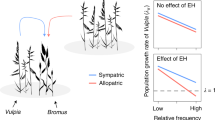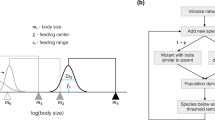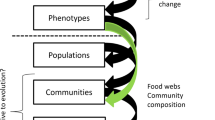Abstract
Evolution has the capacity to alter the course of biological invasions, although such changes remain mostly unexplored by experiments. Integrating evolution into studies of invasions is important, because species traits can potentially evolve in ways that either moderate or exacerbate the impacts of invasions. We have assessed whether species evolved during experimental invasions by comparing the performance of founder populations and their potentially evolved descendants in communities of ciliates and rotifers. Residents (analogous to native species) that have previous experience with invaders consistently reduced the performance of naive invaders, supporting the emergence of increased biotic resistance as one consequence of evolution during invasions. Experienced invaders exhibited both increased and decreased performance depending on the invader species considered. Through its influence on performance and species abundance, evolution also changed community composition during the course of invasions. The idiosyncratic patterns of evolutionary changes in invading and resident species complicate predictions about the long-term consequences of invasions from initial post-invasion dynamics.
This is a preview of subscription content, access via your institution
Access options
Subscribe to this journal
Receive 12 digital issues and online access to articles
$119.00 per year
only $9.92 per issue
Buy this article
- Purchase on Springer Link
- Instant access to full article PDF
Prices may be subject to local taxes which are calculated during checkout





Similar content being viewed by others
References
Simberloff, D. et al. Impacts of biological invasions: what’s what and the way forward. Trends Ecol. Evol. 28, 58–66 (2013).
Lambrinos, J. G. How interactions between ecology and evolution influence contemporary invasion dynamics. Ecology 85, 2061–2070 (2004).
Saul, W.-C. & Jeschke, J. M. Eco-evolutionary experience in novel species interactions. Ecol. Lett. 18, 236–245 (2015).
Strayer, D. L., Eviner, V. T., Jeschke, J. M. & Pace, M. L. Understanding the long-term effects of species invasions. Trends Ecol. Evol. 21, 645–651 (2006).
Palkovacs, E. P. et al. Experimental evaluation of evolution and coevolution as agents of ecosystem change in Trinidadian streams. Phil. Trans. R. Soc. B. 364, 1617–1628 (2009).
Schoener, T. W. The newest synthesis: understanding the interplay of evolutionary and ecological dynamics. Science 331, 426–429 (2011).
Carroll, S. P. Conciliation biology: the eco-evolutionary management of permanently invaded biotic systems. Evol. Appl. 4, 184–199 (2011).
Facon, B. et al. A general eco-evolutionary framework for understanding bioinvasions. Trends Ecol. Evol. 21, 130–135 (2006).
Saul, W.-C., Jeschke, J. & Heger, T. The role of eco-evolutionary experience in invasion success. NeoBiota 17, 57–74 (2013).
Colautti, R. I. & Lau, J. A. Contemporary evolution during invasion: evidence for differentiation, natural selection, and local adaptation. Mol. Ecol 24, 1999–2017 (2015).
Lee, C. E. Evolutionary genetics of invasive species. Trends Ecol. Evol. 17, 386–391 (2002).
Strauss, S. Y., Lau, J. A. & Carroll, S. P. Evolutionary responses of natives to introduced species: what do introductions tell us about natural communities? Ecol. Lett. 9, 354–371 (2006).
Carroll, S. Brave new world: the epistatic foundations of natives adapting to invaders. Genetica 129, 193–204 (2007).
Carroll, S. P. Natives adapting to invasive species: ecology, genes, and the sustainability of conservation. Ecol. Res. 22, 892–901 (2007).
Goergen, E. M., Leger, E. A. & Espeland, E. K. Native perennial grasses show evolutionary response to Bromus tectorum (cheatgrass) invasion. PLoS ONE 6, e18145 (2011).
Mealor, B. A. & Hild, A. L. Post-invasion evolution of native plant populations: a test of biological resilience. Oikos 116, 1493–1500 (2007).
Phillips, B. L., Greenlees, M. J., Brown, G. P. & Shine, R. Predator behaviour and morphology mediates the impact of an invasive species: cane toads and death adders in Australia. Anim. Cons. 13, 53–59 (2010).
Shine, R. Invasive species as drivers of evolutionary change: cane toads in tropical Australia. Evol. Appl. 5, 107–116 (2012).
Strauss, S. Y. Ecological and evolutionary responses in complex communities: implications for invasions and eco-evolutionary feedbacks. Oikos 123, 257–266 (2012).
Carlsson, N. O., Jeschke, J. M., Holmqvist, N. & Kindberg, J. Long-term data on invaders: when the fox is away, the mink will play. Biol. Invasions 12, 633–641 (2010).
Carthey, A. J. & Banks, P. B. Naivete is not forever: responses of a vulnerable native rodent to its long term alien predators. Oikos 125, 918–926 (2015).
Kolbe, J. J. et al. The desire for variety: Italian wall lizard (Podarcis siculus) populations introduced to the United States via the pet trade are derived from multiple native-range sources. Biol. Invasions 15, 775–783 (2012).
Le Roux, J. & Wieczorek, A. Molecular systematics and population genetics of biological invasions: towards a better understanding of invasive species management. Ann. Appl. Biol. 154, 1–17 (2009).
Warren, P. H., Law, R. & Weatherby, A. J. in Conceptual Ecology and Invasion Biology: Reciprocal Approaches to Nature (eds Cadotte, M. C., McMahon, S. M. & Fukami, T. ) 342–367 (Springer, 2006).
Abrams, P. A. Evolution and the consequences of species introductions and deletions. Ecology 77, 1321–1328 (1996).
Jones, E. I. & Gomulkiewicz, R. Biotic interactions, rapid evolution, and the establishment of introduced species. Am. Nat. 179, E28–E36 (2012).
Rummel, J. D. & Roughgarden, J. Some differences between invasion-structured and coevolution-structured competitive communities: a preliminary theoretical analysis. Oikos 41, 477–486 (1983).
DeWitt, T. J. & Scheiner, S. M. in Phenotypic Plasticity: Functional and Conceptual Approaches (eds T. J. DeWitt & S. M. Scheiner), 1–9 (Oxford Univ. Press, 2004).
Hiltunen, T. & Becks, L. Consumer co-evolution as an important component of the eco-evolutionary feedback. Nat. Commun. 5, 5226 (2014).
Urban, M. C. Microgeographic adaptations of spotted salamander morphological defenses in response to a predaceous salamander and beetle. Oikos 119, 646–658 (2010).
Zuppinger-Dingley, D. et al. Selection for niche differentiation in plant communities increases biodiversity effects. Nature 515, 108–111 (2014).
Hairston, N. G., Ellner, S. P., Geber, M. A., Yoshida, T. & Fox, J. A. Rapid evolution and the convergence of ecological and evolutionary time. Ecol. Lett. 8, 1114–1127 (2005).
Falconer, D. Introduction to Quantitative Genetics 4th edn (Pearson Education, 1960).
Koch, H., Frickel, J., Valiadi, M. & Becks, L. Why rapid, adaptive evolution matters for community dynamics. Front. Ecol. Evol. 2, 17 (2014).
The SAS system for Windows v.9.4 (SAS Institute, 2011).
Acknowledgements
This research was supported by Rutgers University (P.J.M.) and a Rutgers University Graduate Program in Ecology and Evolution Ted Stiles Grant (C.A.F). We thank T. Fukami, S. Lawler, S. Naeem, O. Petchey, and members of the Morin Laboratory Group for comments on the manuscript.
Author information
Authors and Affiliations
Contributions
C.A.F. and P.J.M. designed the study. C.A.F. collected and analysed all data. C.A.F. and P.J.M. jointly wrote the manuscript.
Corresponding author
Ethics declarations
Competing interests
The authors declare no competing financial interests.
Supplementary information
Supplementary Information
Supplementary Figures 1 and 2, Supplementary Table 1 (PDF 255 kb)
Rights and permissions
About this article
Cite this article
Faillace, C., Morin, P. Evolution alters the consequences of invasions in experimental communities. Nat Ecol Evol 1, 0013 (2017). https://doi.org/10.1038/s41559-016-0013
Received:
Accepted:
Published:
DOI: https://doi.org/10.1038/s41559-016-0013
This article is cited by
-
How ecological and evolutionary theory expanded the ‘ideal weed’ concept
Oecologia (2023)
-
Microbial invasion of a toxic medium is facilitated by a resident community but inhibited as the community co-evolves
The ISME Journal (2022)
-
Eco-evolutionary interaction between microbiome presence and rapid biofilm evolution determines plant host fitness
Nature Ecology & Evolution (2021)
-
Trends in Studies of Nonnative Populations: Invasions in the Upper Paraná River Floodplain
Wetlands (2020)
-
Uncovering the rules of microbial community invasions
Nature Ecology & Evolution (2019)



